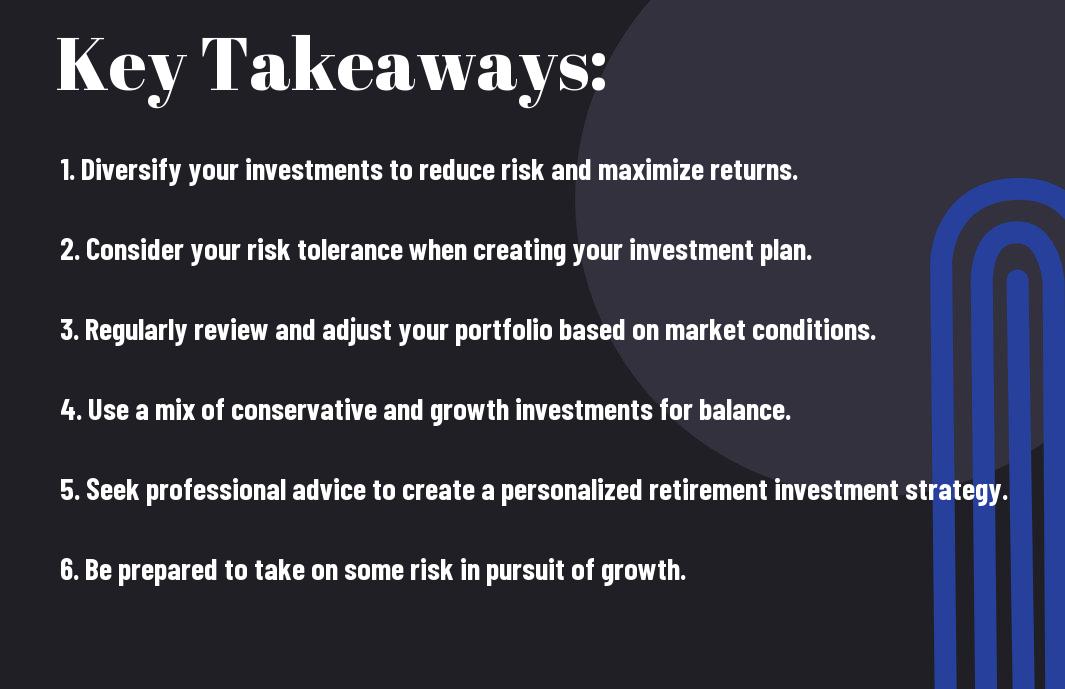Risk is inherent in any investment, especially when it comes to your retirement savings. Finding the right balance between risk and reward is crucial to ensure your financial security in your golden years. Understanding your risk tolerance and diversifying your portfolio are key strategies to mitigate potential losses while aiming for optimal returns. It’s necessary to weigh the potential rewards against the risks carefully and make informed decisions to secure a comfortable retirement.

Key Takeaways:
- Diversify your investments: Spread your retirement savings across different asset classes to reduce risk and increase potential returns.
- Consider your timeline: Adjust your investment strategy based on your time horizon to retirement, shifting towards more conservative investments as you get closer to your retirement date.
- Consult a financial advisor: Seek professional advice to develop a customized retirement investment plan that aligns with your risk tolerance, financial goals, and retirement timeline.

Assessing Your Risk Tolerance
Identifying Your Comfort Level with Market Volatility
To assess your risk tolerance, start by determining how comfortable you are with market fluctuations. Market volatility can cause sudden changes in the value of your investments, which may lead to anxiety or stress. Ask yourself how you would react if your portfolio were to drop by 20% in a short period. Understanding your emotional response can help you gauge your comfort level with risk.
Considering Your Time Horizon and Goals
For a balanced retirement investment plan, consider your time horizon and financial goals. Your time horizon refers to how many years you have until retirement, while your goals include factors like desired retirement lifestyle and legacy planning. Younger investors with a longer time horizon may be more comfortable taking on higher risk for potentially higher returns, while those nearing retirement may prefer a more conservative approach to protect their accumulated savings.

Building a Diversified Portfolio
Some retirement investments carry higher risks but promise higher rewards. According to 7 High-Return, Low-Risk Investments for Retirees, it is crucial for retirees to diversify their portfolio to minimize risk while maximizing returns.
Allocating Assets Wisely
Wisely allocating your assets is key to a successful retirement investment plan. Consider your risk tolerance, time horizon, and financial goals when determining how to distribute your assets among various investment options.
Balancing Stocks, Bonds, and Other Investments
One important aspect of building a diversified portfolio is balancing stocks, bonds, and other investments. Stocks offer high growth potential but come with higher risks, while bonds provide stability but lower returns. Consider mixing different asset classes to create a well-rounded investment strategy that suits your risk tolerance and goals.
Managing Risk Through Strategic Investing
Hedging Against Inflation and Market Downturns
Now, when planning your retirement investment strategy, consider diversifying your portfolio with assets that tend to perform well during inflation or market downturns. Investing in real estate, inflation-protected securities, or commodities can help mitigate the impact of these risks on your overall investment portfolio.
Using Dollar-Cost Averaging to Reduce Timing Risks
To reduce the risk of investing a large sum of money just before a market downturn, consider using dollar-cost averaging. With this strategy, you invest a fixed amount of money at regular intervals, regardless of market conditions. This approach helps smooth out the impact of market volatility and can potentially lead to better long-term returns.
Investing Using Dollar-Cost Averaging to Reduce Timing Risks
Investing through dollar-cost averaging involves consistent and disciplined investing over time. By spreading out your investments, you reduce the risk of making poor timing decisions that could significantly impact your overall returns. This strategy can provide a sense of security and help you stay on track with your long-term financial goals.
Monitoring and Adjusting Your Plan
Regularly Reviewing Your Portfolio’s Performance
Many retirees make the mistake of setting their retirement investment plan and then forgetting about it. To ensure your financial security, it’s crucial to regularly review your portfolio’s performance. This allows you to identify any underperforming assets or areas of risk and make necessary adjustments to stay on track.
Rebalancing Your Investments to Stay on Track
Your retirement goals and risk tolerance may change over time, impacting the allocation of your investments. Rebalancing involves adjusting your portfolio back to its original asset allocation to maintain the desired level of risk and return. This practice ensures that you are not overly exposed to any one asset class and helps protect your portfolio from market volatility.
Investments: Failing to rebalance your investments can lead to a skewed portfolio that is not in line with your retirement goals. By regularly reassessing and rebalancing your investments, you can stay on track towards achieving a secure financial future.
Final Words
With these considerations in mind, it’s crucial to strike a balance between risk and reward in your retirement investment plan. By carefully assessing your financial goals, timeline, and risk tolerance, you can create a diversified portfolio that aligns with your needs. Do not forget, always consult with a financial advisor to ensure you’re making informed decisions that will help secure your financial future.
FAQ
Q: Why is it important to balance risk and reward in your retirement investment plan?
A: Balancing risk and reward in your retirement investment plan is crucial because it helps you achieve your financial goals while managing the level of risk you are comfortable with. By finding the right balance, you can potentially maximize your returns without taking on unnecessary risks that could jeopardize your retirement savings.
Q: How can I determine the right balance of risk and reward for my retirement investments?
A: To determine the right balance of risk and reward for your retirement investments, you should assess your financial goals, risk tolerance, and time horizon. Consider working with a financial advisor who can help you create a diversified investment portfolio that aligns with your objectives and risk tolerance.
What are some strategies for balancing risk and reward in a retirement investment plan?
A: Some strategies for balancing risk and reward in a retirement investment plan include diversifying your portfolio across different asset classes, rebalancing regularly to maintain your desired risk level, and considering investments with varying risk profiles such as stocks, bonds, and real estate. It’s important to regularly review and adjust your investment strategy as needed to ensure it continues to align with your retirement goals.






